|
VARIETIES.
What
varieties, to plant is one of the puzzling questions which every
inexperienced cultivator desires to have answered. If he consults the
catalogues of dealers, he is certain to find that the newest and
highest-priced variety is the one above all others that he should
select. But if he pursues his investigations a little farther in this
direction, and examines the lists of a dozen different dealers in
plants, he will probably find that no two agree, each having some
special variety to offer, as the very best and most promising one
known. But as society is now constituted it is considered as
perfectly legitimate for a dealer to extol his wares, even far above
what their merit would warrant if the actual truth about them was
told; consequently, we are not surprised to be informed by the
introducer of new varieties, that each and every one offered is
far superior to anything of the kind heretofore known: "Yielding
double the quantity of any other variety" has become a
stereotyped phrase in advertising new varieties, and yet every
experienced cultivator of Strawberries knows that the Wilson,
introduced nearly thirty years ago, has never been excelled in
productiveness. A variety, which, under the same conditions,
would produce double the quantity of this old favorite, might
certainly be considered something unique in the way of a Strawberry.
Strange
as it may appear to the novice in fruit culture, varieties which
are most highly praised at their introduction, are quite
frequently the first to disappear from cultivation, while others gain
a prominent position in spite of all opposition. The Wilson, when
first exhibited, and for years afterwards, met with opposition and
was denounced as unfit for cultivation or use by some of the most
prominent pomologists in the country. Yet it continued to grow in
favor until, within the past decade or less, it was more extensively
cultivated than any other variety, and probably there were more acres
planted with it than all the others put together, and even at this
late day it is considered a standard and profitable berry.
This
variety was said to be too acid and too dark colored for a market
berry, and the late berries on the plant were too small, all of which
is true, but the fruit is very firm, withstands long carriage and
rough handling, and when it comes to filling the baskets and
crates at gathering time the Wilson rarely disappointed the
cultivator or consumer, who sought the markets for his supply of
Strawberries.
The
lesson to be learned from the erratic reputation of the Wilson is
that first impressions are not always trustworthy, and a variety may
prove better than it promises when first introduced, although it must
be admitted that the chances are ten to one against the very
best of new sorts.
In
the following select list of varieties I propose mentioning only
those which have gained a local or widespread reputation for
excellence, without regard to the length of time they may have been
in cultivation. Pistillate varieties are indicated by the letter P.
Agriculturist.
— Very large, irregular, conical; with long neck, large specimens often
flattened or coxcomb shape; color light red or reddish crimson. A large
and valuable variety for garden culture, but when cultivated in beds
the fruit is only of medium size, as shown in Fig. 10.
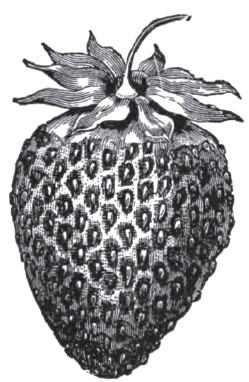
Fig.
10 — AMERICAN AGRICULTURALIST
Bidwell.
— Large, irregular, conical; bright scarlet; flesh only moderately
firm; quality excellent. A vigorous grower, and in heavy soils quite
productive. Its reputation as a market variety is rather local.
Black
Defiance. — Large, irregular in shape; dark glossy
crimson; flesh moderately firm; high flavored. Color too dark and
dull for market, but a good berry for home use.
Brooklyn
Scarlet. — Medium to large, regular conical with neck, as
shown in Fig. 11; color bright light scarlet; flesh rather soft, sweet
and rich; quality best. An excellent variety for home use,
but now rarely seen in cultivation.
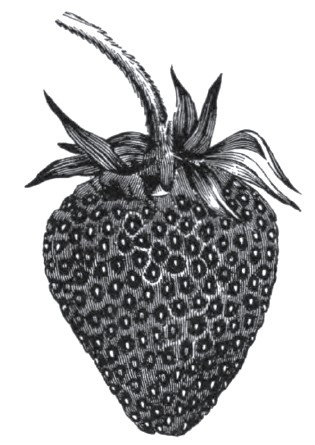
Fig. 11 —
Brooklyn
Scarlet
Champion
(Windsor Chief. — P.) — Large round; bright crimson;
flesh
rather soft and of a spicy acid flavor, only second best. Plants
vigorous and exceedingly productive when planted in rich soils
and near a variety yielding an abundance of pollen.
Charles
Downing. — Medium to large, round obtuse conical; very
regular in form; bright scarlet, becoming darker when fully
ripe; flesh moderately firm, pink, juicy. with a rich, sprightly
subacid flavor. One of the very best and most popular varieties in
cultivation, and now extensively cultivated for market in all of our
Northern States. The plants are very hardy and yield a heavy crop
when cultivated in rows or matted beds.
Crescent.
— Medium to large, somewhat irregular conical; bright scarlet;
flesh rather soft for a market berry, but will carry well for a short
distance; quality fair but not rich; the plants, however, are so
productive that this variety has been called "The lazy man's
berry."
Cumberland
Triumph (Jumbo). — Very large obtuse conical, but under
high culture, or when forced under glass, is somewhat irregular;
light bright scarlet; flesh pale pink of excellent flavor. A vigorous
grower and very productive in strong fertile soils. Very popular
among amateur cultivators of the Strawberry.
Downer's
Prolific. — Medium, globular, light scarlet; seed deeply
imbedded; flesh rather soft, acid, not rich, but highly perfumed.
This is an old variety, but so very hardy and prolific that it is
still cultivated more or less extensively for market.
Durand.
— Large, oblong or oblong conical (Fig. 12), sometimes flattened, seeds
but slightly imbedded; color scarlet; flesh firm, solid; nearly white,
of good flavor. This variety has only a moderate local reputation
among amateurs.
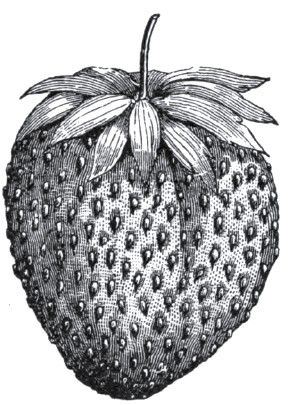
Fig. 12 — DURAND
Forest
Rose. — Large, irregular, obtuse conical; bright scarlet;
flesh firm, of good flavor.; a superior market variety, but does not
succeed well in all kinds of soils that are usually considered well
adapted to the Strawberry. (Fig. 13).

Fig. 13 — FOREST ROSE
Glendale.
— Large, regular, conical; dull scarlet; flesh firm, acid, not
first quality, but a valuable late variety
for market. Succeeds best on rather firm soils and poorly on sandy
land.
Green Prolific.
— Large round; pale crimson or deep scarlet; seeds slightly sunken,
rather soft, acid, without richness, but highly perfumed. A wonderfully
hardy and productive variety; extensively cultivated a few years since
for market, as it succeeds on a great variety of soils, and when left
to grow with little or no cultivation. Fig. 14 shows a berry about
average size from matted rows and beds.
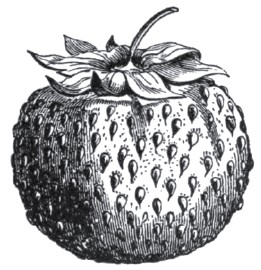
Fig. 14 —GREEN PROLIFIC
Hovey
(P.). — Large conical; bright crimson; sub acid,
sprightly
and good. The oldest American variety of any note, and, although it
has been in constant cultivation for nearly a half century, it is
still popular in restricted localities, and especially in
Massachusetts whore it originated. Three prizes are offered for
the Hovey by the "Massachusetts Horticultural Society"
at its forthcoming Strawberry Exhibition, June 21 and 22.
Jewell.
— Very large, obtuse conical; bright crimson; very firm and of fine
flavor. This variety was awarded a silver medal by the Massachusetts
Horticultural Society in 1880. Highly recommended for home use and
market.
Jessie.
— This new variety was raised in 1880 by Mr. F. W. Loudon, of
Wisconsin; it is a seedling of the Sharpless, and partakes of all the
most desirable qualities of its parent. The originator describes
the plant as "a stout, luxuriant grower, with light-green, large
and clean foliage, which bas never shown signs of rust; the berry
very large, continuing of good size to the last picking; it is of
beautiful red color, fine quality, good form, colors even with no
white tips, and is firm enough for shipping great distances."
From all that I can learn about this new variety it seems to be well
worthy of trial.
Jucunda.
— Large conical; bright crimson, excellent flower; a strong and
vigorous grower on rich and heavy soils, but almost worthless on light
or sandy soils. A foreign variety, first disseminated in this country
under the name of Knox's 700. It is still cultivated about Boston bat
rarely elsewhere. (Fig. 15).
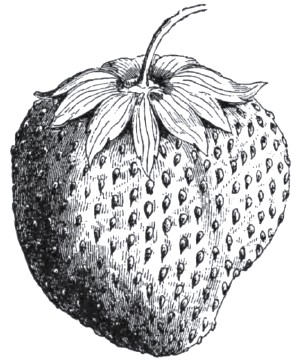
Fig. 15 —JUCUNDA
Kentucky.
— Medium to large, conical; bright scarlet; flesh white,
moderately firm,
excellent flavor; ripens late and continues in fruit a long
time. Plants vigorous, hardy and very productive. Succeeds well on
light soils.
Lennig's
White. — Large obtuse conical; seed prominent and of a pink
or
light crimson color in the sun; fruit almost white, but with a
delicate blush on the side exposed to the sun. This is evidently a
seedling of the Chili species, and it is rather tender and
unproductive, but withal an excellent variety.
Miner's
Great Prolific. — Large to very large; somewhat irregular but
inclining to a globular form; deep bright crimson; flesh pink, firm
and of good flavor; plant vigorous, leaves largo, light green, quite
glossy. A very popular variety among amateurs as well as those who
cultivate Strawberries extensively for market.
President
Wilder. — Medium, obtuse conical, very regular; seeds yellow;
skin bright glossy scarlet; flesh firm, but juicy and very high
flavored. One of the handsomest varieties in cultivation, but the
plants are rather delicate and the leaves burn during the hot weather
in summer. Said to succeed well in the New England States, but I have
not learned of its success elsewhere.
Seth
Boyden. — Very large, irregular, conical with long neck; dull
crimson; flesh firm, rather dry, sweet and of excellent flavor;
plant, extra vigorous and productive when cultivated in hills
and in a rich soil. One of the very best and most valuable of all the
extra large varieties.
Sharpless.
— This is another of the mammoth varieties and the more remarkable
because it has proved to be all that was claimed for it when first
introduced. Uniformly large; often broadly wedge-form and wider at
the top than at the calyx; light glossy red; flesh firm, juicy, rich
and highly perfumed; plant vigorous and productive. One of the very
best.
Triomphe de Gand.
— One of the most popular and valuable varieties ever introduced. Very
large irregular, conical, but often flattened or coxcomb shape as in
Fig. 16, pale or bright; flesh very firm, crop not rich, but of a mild
and pleasant flavor. This variety has probably been more extensively
cultivated, and given better satisfaction than any foreign variety, and
it has no superior to this day for size or production of the plants.
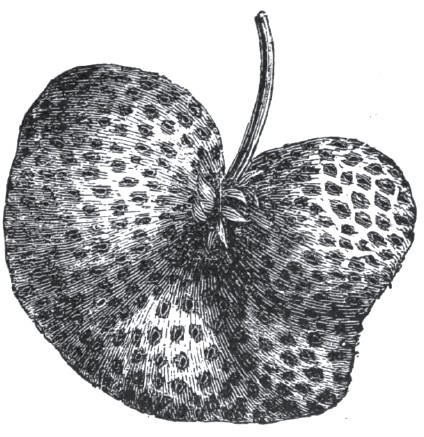
Fig.
16 — Triomphe
de Gand
Wilson
or Wilson's Albany. — An old and well-known variety. Large,
irregular, conical; dark crimson when fully ripe; flesh crimson, very
firm, acid, but good and bears transportation well. One of the most
productive varieties known.
NEWER
AND LESS KNOWN VARIETIES.
Henderson.
— Said to be of the largest size, early and unusually productive,
and of exquisite flavor.
Indiana.
— Claimed to be an improvement on the Charles Downing, but similar
in size, color and quality.
Lida
(P). — One of Mr. Durand's seedlings, claimed to be of very
large size; heart shaped; bright red color, excellent flavor, and the
plants very productive.
May
King. — Seedlings of the Crescent, and resembles its parent,
but the flowers are perfect. Berries are not large but ripen early
and are produced in great abundance.
Old
Iron Clad or Phelps. — I obtained this variety under the last
name, and have been much pleased with it. Fruit medium, conical;
bright crimson; firm and rather acid but good. Plants very
productive.
Parry.
— Highly recommended for its large size, and has been awarded
several prizes at various Strawberry shows in New York and elsewhere.
Plants said to withstand droughts better than any other variety.
THE
HAUTBOIS AND ALPINE STRAWBERRIES.
All
of the varieties of the Hautbois Strawberry (Fragaria elatior) have a
rather strong musky odor, which is rather disagreeable to most
persons, and the fruit is usually of a dull red or greenish color and
not very attractive in appearance. They are altogether inferior
to the varieties of other species, and for this reason are rarely
cultivated except in the gardens of botanists.
The
Alpine Strawberry (F. vesca), on the contrary, is of
a very
mild flavor with a delicious perfume. There are quite a large number
of varieties in cultivation in Europe, and, while none yield very
large berries, they are mostly quite prolific and will thrive in cold
exposed positions where those of other species would perish.
In
the catalogues of European nurserymen and those who make Strawberry
growing a specialty, we may find thirty or more varieties of the
Alpine Strawberry described, but the larger proportion of the
names used in these catalogues are mere synonyms, and it would
probably be difficult to find a dozen really distinct varieties of
this species in all Europe. There are, however, four really distinct
varieties, all long known in this country, and now generally
cultivated in European countries although under various names. These
are:
Red-Bush
Alpine. — Fruit medium size, conical; bright red; seeds
prominent, not sunken as usual in the common Strawberry; flavor mild,
not highly but delicately perfumed. Plants continue bearing from
June till checked by frosts in autumn. In rich soils the plants will
yield well throughout the entire season. As they produce no runners
they must be propagated by divisions.
White-Bush
Alpine. — In every respect the same as last except the fruit
is
pure white.
Red-Monthly
Alpine. — Fruit very similar but usually a little larger than
that of the Bush-Alpines, but plants produce runners freely, and the
new plants on the runners bloom and bear fruit the first season,
thereby keeping up a succession of berries from June to the close of
the season.
White-Monthly
Alpine. — This is a variety of the last, but with pure white
fruit. The Monthly Alpines with runners are elegant conservatory
plants, or they may be used for trailing over wire screens and for
hanging baskets in window gardening.
PROFITS
OF STRAWBERRY CULTURE.
Persons
who have had no experience in raising Strawberries, but are
considering the subject of cultivating them for market, are usually
very desirous of ascertaining in advance what the prospects are
for deriving a profit on their proposed investment. Unfortunately,
however, for the would-be investor in such an enterprise,
results depend greatly upon circumstances, such as available markets
within a reasonable distance; . plenty of labor at a moderate price
and at a season when needed most; cheap lands and fertilizers,
and last, but not least, favorable seasons. If a man must depend upon
hired labor to gather his fruit he is never certain, in these days of
"Strikes," what it is going to cost him to gather and
prepare it for market. The most clear profit made in the cultivation
of the Strawberry for market is by the small farmers and gardeners in
the suburbs or within a moderate distance of our large cities, who
have children to assist in gathering the fruit or can always depend
upon those of their neighbors to lend a hand when needed. An acre of
Strawberries under high cultivation, with the fruit gathered and
marketed in the very best condition, will often yield more clear
profit to the grower than ten acres under opposite conditions.
Circumstances
have changed since the first edition of this little treatise was
written, for at that time our large cities and villages were wholly
supplied with small fruit by the farmers and gardeners in their
immediate vicinity, and, if the seasons were unfavorable, the price
of fruit advanced in proportion, and the grower was sure of obtaining
a fair remuneration for his labor whether he had a large or limited
crop of fruit. But all this is now changed, for railroads have
practically annihilated distance in the transportation of perishable
commodities of all kinds, and the Strawberry growers of no one
locality or region of the country are masters of their own local
markets. for those residing a hundred or even five-hundred miles away
may become their most persistent and successful competitors. If a
market is not fully supplied, and prices go up in consequence, the
telegraph conveys the information to those who may be able to supply
the deficiency; hence local monopolies are no longer possible.
The Strawberry season in our Northern cities opens with fruit from
Florida, and continues until the last crate comes in from Maine or
Canada, and yet, fresh, choice, large fruit usually commands a fairly
remunerative price in all of our large cities and villages
throughout the entire country.
While
the profits of Strawberry culture are not so large as they were
twenty or thirty years ago, still, they are sufficient to induce
those who have longest made the cultivation of this berry a
specialty, to continue in the business. On good land, with the best
and most productive varieties, one to three hundred dollars per
acre profit are usually realized, which is a far greater sum than is
generally obtained from any of the leading farm crops.
|